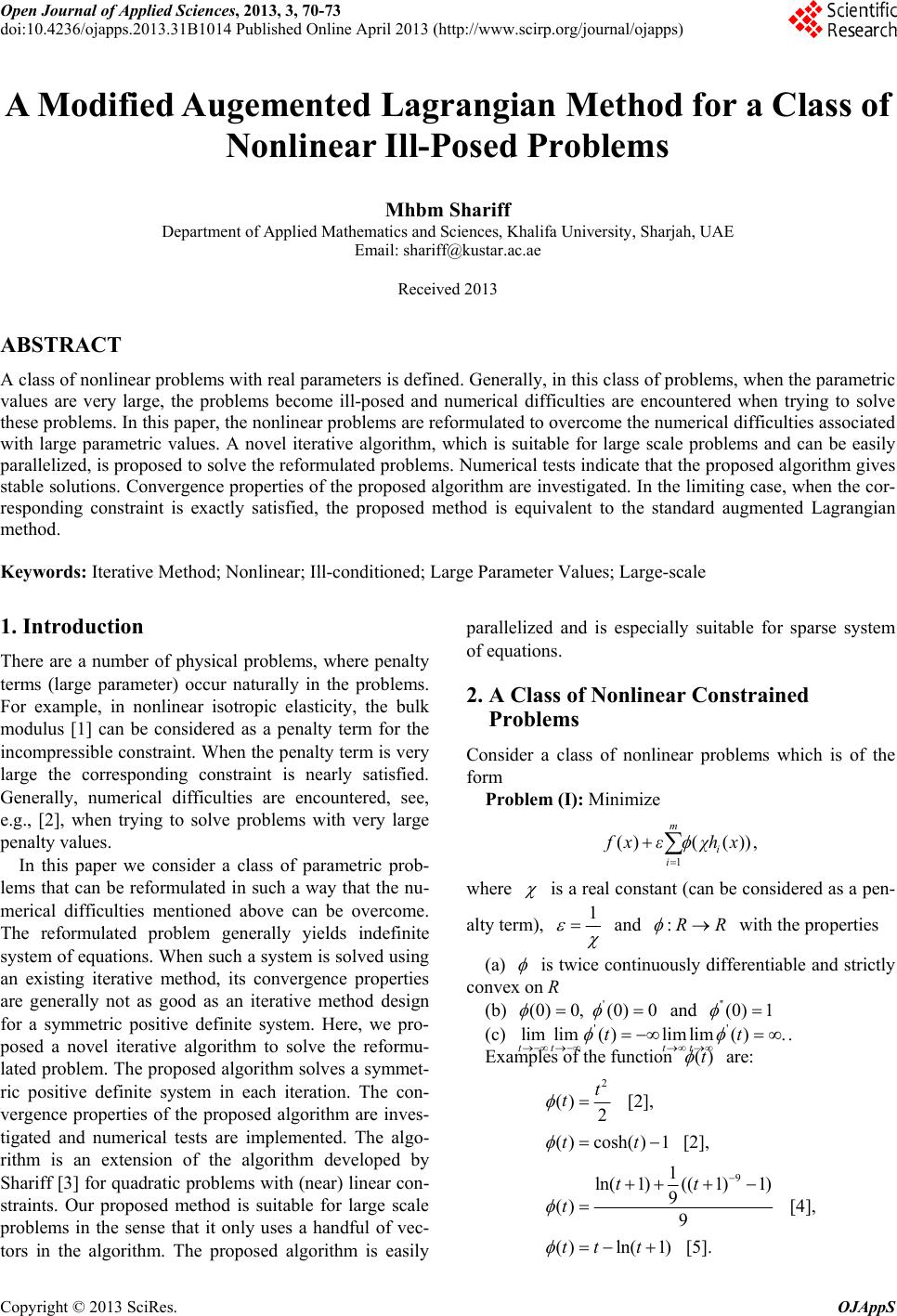
Open Journal of Applied Sciences, 2013, 3, 70-73
doi:10.4236/ojapps.2013.31B1014 Published Online April 2013 (http://www.scirp.org/journal/ojapps)
A Modified Augemented Lagrangian Method for a Class of
Nonlinear Ill-Posed Problems
Mhbm Shariff
Department of Applied Mathematics and Sciences, Khalifa University, Sharjah, UAE
Email: shariff@kustar.ac.ae
Received 2013
ABSTRACT
A class of nonlinear problems with real parameters is defined. Generally, in this class of problems, when the parametric
values are very large, the problems become ill-posed and numerical difficulties are encountered when trying to solve
these problems. In this paper, the nonlinear problems are reformulated to overcome the numerical difficulties associated
with large parametric values. A novel iterative algorithm, which is suitable for large scale problems and can be easily
parallelized, is proposed to solve the reformulated problems. Numerical tests indicate that the proposed algorithm gives
stable solutions. Convergence properties of the proposed algorithm are investigated. In the limiting case, when the cor-
responding constraint is exactly satisfied, the proposed method is equivalent to the standard augmented Lagrangian
method.
Keywords: Iterative Method; Nonlinear; Ill-conditioned; Large Parameter Values; Large-scale
1. Introduction
There are a number of physical problems, where penalty
terms (large parameter) occur naturally in the problems.
For example, in nonlinear isotropic elasticity, the bulk
modulus [1] can be considered as a penalty term for the
incompressible constraint. When the penalty term is very
large the corresponding constraint is nearly satisfied.
Generally, numerical difficulties are encountered, see,
e.g., [2], when trying to solve problems with very large
penalty values.
In this paper we consider a class of parametric prob-
lems that can be reformulated in such a way that the nu-
merical difficulties mentioned above can be overcome.
The reformulated problem generally yields indefinite
system of equations. When such a system is solved using
an existing iterative method, its convergence properties
are generally not as good as an iterative method design
for a symmetric positive definite system. Here, we pro-
posed a novel iterative algorithm to solve the reformu-
lated problem. The proposed algorithm solves a symmet-
ric positive definite system in each iteration. The con-
vergence properties of the proposed algorithm are inves-
tigated and numerical tests are implemented. The algo-
rithm is an extension of the algorithm developed by
Shariff [3] for quadratic problems with (near) linear con-
straints. Our proposed method is suitable for large scale
problems in the sense that it only uses a handful of vec-
tors in the algorithm. The proposed algorithm is easily
parallelized and is especially suitable for sparse system
of equations.
2. A Class of Nonlinear Constrained
Problems
Consider a class of nonlinear problems which is of the
form
Problem (I): Minimize
1
()( ()),
m
i
i
fx εχhx
where
is a real constant (can be considered as a pen-
alty term), 1
and :RR
with the properties
(a)
is twice continuously differentiable and strictly
convex on R
(b) '
(0)0, (0)0
limlim( )l
and
'' (0) 1
''
im( )
(c) .im l
tt
tt t
Examples of the function t
()t
.
are:
2
9
() [2],
2
()cosh()1 [2],
1
ln( 1)(( 1)1)
9
() [4],
9
()ln(1) [5].
t
t
tt
tt
t
tt t
Copyright © 2013 SciRes. OJAppS